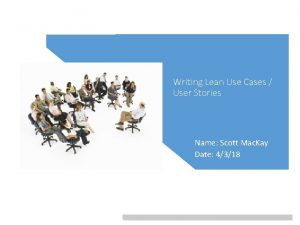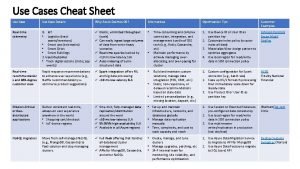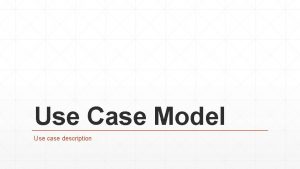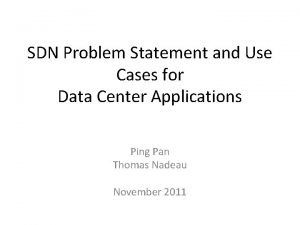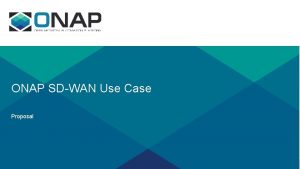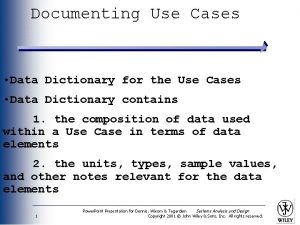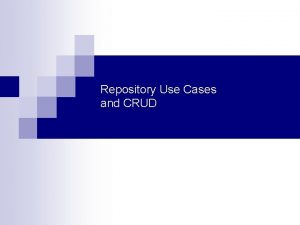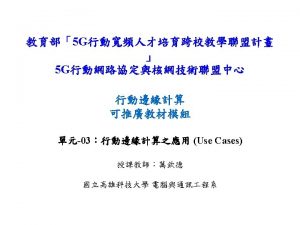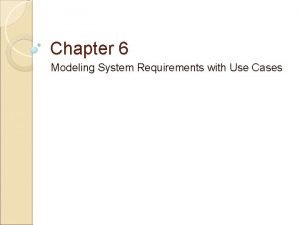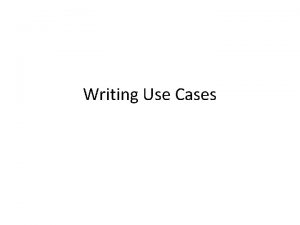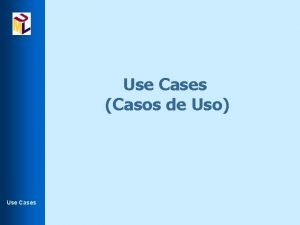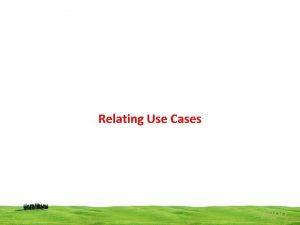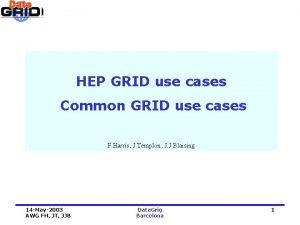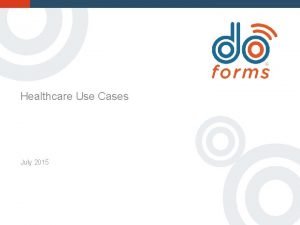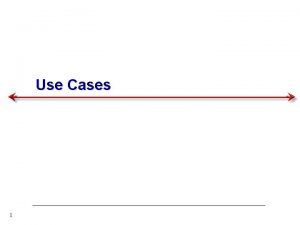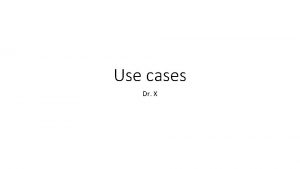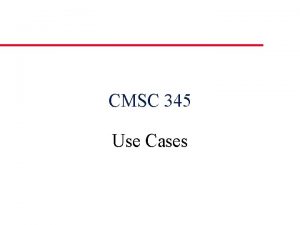Chapter 9 Use Cases Use Cases Use cases
















- Slides: 16

Chapter 9 Use Cases

Use Cases • “Use cases are a technique for capturing the functional requirements of a system. Use cases work by describing the typical interactions between the users of a system and the system itself, providing a narrative of how the system is used” • Use case development process … – Develop multiple scenarios – Distill the scenarios into one or more use cases where each use case represents a functional requirement – Establish associations between the use cases and actors 2

Use Cases • A use case. . . – Specifies the behavior of a system or some subset of a system – Is a set of scenarios tied together by a common user goal – Does not indicative how the specified behavior is implemented, only what the behavior is. – Performs a service for some user of the system. • A user of the system is known as an actor. – During the analysis phase, facilitates communication between the customer, users of the system and the developers of the system. 3

Use Cases • A use case. . . – Represents a functional requirement of the system • A requirement … – – Is a design feature, property, or behavior of a system States what needs to be done, but not how it is to be done Is a contract between the customer and the developer Can be expressed in various forms, including use cases – Is graphically represented as an oval with the name of its functionality written inside. • Functionality is always expressed as a verb or a verb phrase. – may exist in relationships with other use cases much in the same way as classes maintain relationships with other classes. 4

Actors • An actor. . . – – – is a role that the user plays with respect to the system is associated with one or more use cases does not have to be human is a user of the system is most typically represented as a stick figure of a person labeled with its role name • Role names should be nouns – may exist in a generalization relationships with other actors in the same way as classes may maintain a generalization relationships with other classes 5

Actors • An actor … – may be drawn as a stereotyped class or a graphical image of your own design – are connected to use cases by associations – exist outside the system boundaries 6

Actors and Use Cases Graphical representation of an actor and a use case 7

Actors and Use Cases Generalization between actors 8

Contents of a Use Case • Use cases and Flow of Events – A use case, by itself, does not describe the flow of events needed to carry out the use case. – Flow of events can be described using informal text, pseudocode, or activity diagrams. • May use a note to attach flow of events documentation to a use case. • Rose can link an activity diagram to a use case – Be sure to address exception handling (error conditions) when describing flow of events. – “The amount to detail you need in a use case depends on the amount of risk in that use case” 9

Contents of a Use Case It is possible to have hybrid diagrams that contain symbols found in different types of diagrams 10

Use Case Diagrams • Organizing Use Cases – A use case diagram is a graphical table of contents – A cases may have a relationship with other use cases • Generalization between use cases is used to extend the behavior of a parent use case. • An <<include>> relationship between use cases means that the base use case explicitly incorporates the behavior of another use case at a location specified in the base. 11

Use Case Diagrams • Sometimes the <<uses> stereotype is used instead of <<include>> • An <<extend>> relationship between use cases means that the base use case implicitly incorporates the behavior of another use case at a location specified indirectly by the extending use case • Extended behavior is optional behavior, while included behavior is required behavior 12

Use Case Diagrams 13

Use Case Diagrams 14

Use Case Diagram 15

Use Case Diagrams 16
 Criminal cases vs civil cases
Criminal cases vs civil cases How to write use cases
How to write use cases Writing effective use cases
Writing effective use cases Use case diagram cheat sheet
Use case diagram cheat sheet Use case description
Use case description Couchbase full text search example
Couchbase full text search example Service chaining use cases
Service chaining use cases Sdn use cases
Sdn use cases Sd wan proposal
Sd wan proposal Documenting use cases
Documenting use cases Hyperledger use cases
Hyperledger use cases Use cases agile
Use cases agile Crud use case
Crud use case Oran use cases
Oran use cases Mec use cases
Mec use cases Use cases and requirements
Use cases and requirements Fully dressed use case
Fully dressed use case

